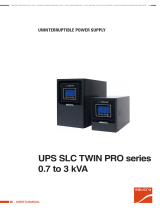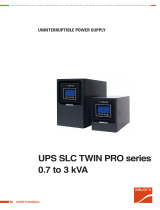Page is loading ...

Black Gold Single Phase Uninterruptible Power Supply Systems
Guide Specifications
2.0kVA Industrial Rackmount
Page 1 of 5
1.0 Scope
This specification describes the requirements for an On-Line Uninterruptible Power
Supply (UPS). The UPS will supply a computer grade AC output sinewave which is
unaffected by the quality of the AC input. The input voltage shall be single phase with
the output voltage being single phase.
2.0 General Operation
Under normal operating conditions, the UPS's rectifier converts alternating current (AC
power) to direct current (DC power), which is required for the system's inverter and
battery charger. The charger supplies regulated DC power to keep the batteries
constantly charged. The inverter uses pulse width modulation (PWM) that fully utilizes
the characteristics of insulated-gate bipolar transistors (IGBT) to convert DC power to
regulated AC power. Therefore there is a constant supply of power. The batteries will
instantaneously supply the inverter DC power should an AC power line failure occur.
2.1 Performance Standards
The UPS shall be designed with the applicable sections of UL, CSA, NEMA PE-1, and
IEEE-587(ANSI C62.41). The UPS shall have UL 1778 listing and is CUL certified..
3.0 General
3.1 Materials
All materials used are of new manufacture using the latest technology and should not
have been in prior service except for specified factory testing. IGBT's (insulated-gate
bipolar transistors) are used exclusively in inverter and chopper sections.
3.2 Components
All functioning components are solid state with no moving parts.
3.3 Installation
The installation of the UPS must comply with the UPS manufacturer's recommendations
that will be supplied before delivery of the UPS. Local electrical codes and the National
Electric Code must be complied with. All wiring must comply exactly with what is
specified.
3.4 Assembly
The UPS shall be delivered fully assembled and be fully functional.
Line Cord: 5-20P
Receptacle Panel: Six 5-15R (120V In / 120V Out)
Six IEC 320 (230V in / 230V Out)
4.0 System Theory and Operation
4.1 Theory
AC input from the utility system is converted into DC power by a diode bridge rectifier
and stepped up by the chopper. The stepped up DC power is then converted to AC power
by the inverter. The output voltage waveform of the inverter will be the pulse voltage

Black Gold Single Phase Uninterruptible Power Supply Systems
Guide Specifications
2.0kVA Industrial Rackmount
Page 2 of 5
waveform modulated by the PWM control using the 16 KHz switching frequency
sinewave. The PWM-Modulated voltage waveform is transformed into a sine voltage
waveform by the inductive component of the inverter transformer and by the capacitive
component of the capacitor filter. The chopper, inverter, and charger use the IGBT with
a self-extinguishing function and a high switching speed.
4.2 Modes of Operation
4.2.1 Emergency (Battery Backup)
In the event the AC power from the utility system fails, the DC power is supplied from
the batteries to the chopper and to the inverter to provide a continued and stable AC
power supply to the load without interruption.
4.2.2 Normal (Inverter)
The rectifier converts AC to DC to power the inverter, which supplies power to the
critical load and simultaneously float charging the batteries.
4.2.3 Battery Charge
The charger will float charge the batteries while no load is being powered by normal
mode.
4.2.4 Static Bypass
The load is being powered by an alternate source by being transferred from normal mode
to bypass mode by the bypass switch. This mode is used during overload and
maintenance repair. Power is conditioned by M.O.V.'s and a line filter during bypass
operation.
5.0 UPS Input
5.1 System Rating The UPS's are sized to supply a load with a power factor of 0.70.
5.2 Electrical Requirements
Voltage: 120 VAC Single Phase +10%/-30%
Frequency: 50 or 60 Hz +/- 5 Hz
Input Harmonic Distortion: less than 10% THD (current)
Input capacity: 1.0 times output capacity
Input power: approximately 1.0 power factor (unity)
5.2.2 Battery Bus
Volts: 2.0 KVA 72 VDC nominal
Backup time: 6 mins @ full load/18 mins @ half load

Black Gold Single Phase Uninterruptible Power Supply Systems
Guide Specifications
2.0kVA Industrial Rackmount
Page 3 of 5
Average Recharge: 24 hours (8 hours for 90%)
Type of Battery: sealed lead acid
Voltage Range: 2.0 KVA 57.6 – 82.8VDC
Cutoff Voltage: 1.60 VPC
6.0 UPS Output
Capacity: 2.0 KVA 1.40 KW
Voltage: 120 VAC Single phase
Regulation: +/-3% (with AC power and during battery backup)
Frequency: (50/60Hz)
Regulation: +/- 0.5% in free run mode
Synchronous range: +/- 1%
Rated Load Power Factor: 0.7 lagging
Crest Factor: 3
Transient Characteristics: +/- 5% for 100% load step change
Overload Capacity (Inverter): 150% For 60 seconds
1000% for 1 cycle
THD (Total Harmonic Distortion): 1% typical
3% maximum under linear load
Efficiency: 89%
Acoustical Noise: 45 dB(max), at 1 meter from front panel
Output Current: RMS
PEAK
2.0 KVA 16.6A 50.0A
6.1 Bypass
If the UPS unit is overloaded or develops an internal fault, the power is automatically
switched from the unit's main circuit to the bypass circuit mode. The UPS equipment
load will be supplied by utility power through the bypass circuit. This changeover occurs
in less than 4 milliseconds. The switching period is not long enough to cause
interruptions to occur in your UPS equipment load.

Black Gold Single Phase Uninterruptible Power Supply Systems
Guide Specifications
2.0kVA Industrial Rackmount
Page 4 of 5
There is also a switch on the front panel (Run/Stop) that allows you to manually switch
from UPS to bypass mode. (Run - UPS mode, Stop - Bypass mode).
7.0 System Status and Control Indicators
7.1 Panel
The UPS has a panel on the front for complete monitoring of UPS.
Operation Panel:
1) Run/Stop
2) Fault indicator
3) AC Line indicator
4) Inverter indicator
5) 8 Segment LED Display
The eight segment LED display will indicate the following:
1) Output Load (normal operation)
2) Battery Voltage Level (during input AC failure)
3) Self-diagnostics (UPS faults)
Fatal Faults:
1) Input overcurrent
2) DC overcurrent
3) DC overvoltage
4) UPS system error
Non-Fatal Faults:
1) Output overvoltage
2) Output low voltage
3) DC undervoltage
4) Overheat
5) Battery problem
8.0 Dimensions
2.0 KVA
Weight 119 lbs
Depth 24”
Width 16.75”
Height 5.25”
9.0 Communications
UPS comes with 4 dry contact signals relayed through a DB9 male connector.

Black Gold Single Phase Uninterruptible Power Supply Systems
Guide Specifications
2.0kVA Industrial Rackmount
Page 5 of 5
1) AC input present
2) Low battery
3) Inverter
4) Bypass Active
All signals are (NO) in configuration with standard AS/400 interfaces.
UPS comes with a RS232 communication port for serial communication.
10.0 Reliability
Demonstrated mean time between failures (MTBF) of 200,000 hours.
11.0 Warranty
Every UPS comes with a "Security Plus" Warranty. This warranty provides on- site
service for 3 years after shipment including parts and labor.
12.0 Options
12.1 Remote Monitoring
The UPS contains a communication slot this allows the operator to field install an
optional RemotEye II card. The RemotEye II card shall allow the UPS to communicate
via Ethernet SNMP, connected directly to the Local Area Network. SNMP/ Web based
monitoring – Toshiba UPS system provides comprehensive monitoring of the UPS
operation. The optional RemotEye II features an HTTP (web-based) interface for
Toshiba UPS. This allows easy access to the Toshiba UPS information from any
PC/Network with a web browser.
12.2 Environmental Monitoring Device (EMD)
The EMD is an environmental monitoring device that provides remote monitoring of
temperature, humidity and other environmental conditions via standard web browser or
network management systems. The EMD provides automated events notification when
temperature, humidity or user defined dry contacts is out of configured tolerance.
/

